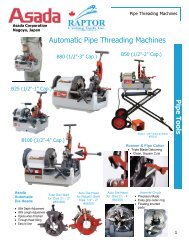Why are these plumbers hanging drywall? - Plumbing & HVAC
Why are these plumbers hanging drywall? - Plumbing & HVAC
Why are these plumbers hanging drywall? - Plumbing & HVAC
Create successful ePaper yourself
Turn your PDF publications into a flip-book with our unique Google optimized e-Paper software.
Air ConditioningDuct-freeA solution for difficult air conditioning applicationsBy Simon BlakeAs more Canadians view air conditioningas a necessity, the industryhas found ways to bring coolingvirtually anywhere. However, homesthat lack ductwork or where the ductworkis inadequate can be a challengefor the <strong>HVAC</strong> contractor. ‘Duct-free’ or‘ductless’ mini-split systems offer asolution.These systems have evolved to thepoint where they can be an alternativeto conventional central air systems insome residentialand small to medium-sizedcommercialbuildings.“When designedand installed properly,it’s amazinghow well theywork,” remarked LesSzarka, generalmanager for Carrier Canada, centralregion.In some cases, it’s easier to install aductless system than to upgrade anexisting central air system. “We do a lotof third floor applications where theductwork doesn’t provide adequatecooling,” reported Rob Robertson, directorof operations, Quietside Corporationof Canada, Peterborough, Ont.Duct-free split systems were developedin Japan in the late 70s by separatingthe components of compact standalone(‘window-shaker’) air conditioningunit to create a quieter and morepermanent solution. The outdoor condenserconsists of one or more hermeticcompressors and a heat exchangerwith an axial fan. The indoor unit,located in the <strong>are</strong>a to be cooled, alsohouses a heat exchanger and fan. Someincorporate variable airflow. The indoorand outdoor units <strong>are</strong> connected througha small diameter refrigerant lineset.The operation is simple, in principleanyway. Room air is pulled into theindoor unit through an intake grill andfilter, cooled and dehumidified on theevaporator surface and then transportedback into the room through air baffles.Heat is transferred to the outdoorunit through the lineset and rejectedinto the atmosphere.New technologies <strong>are</strong>revolutionizing whereand how duct-freesystems canbe used.Today’s systems can be divided intotwo camps: mono systems with oneoutdoor and indoor unit and multi systemswith up to 32 heads, depending onmanufacturer, for each outdoor condenser.New technologiesNew technologies <strong>are</strong> revolutionizingwhere and how duct-free systems can beused, reports Anton Wolmarans, generalmanager for Mitsubishi Electric SalesCanada Inc., Markham,Ont. Variablerefrigerant flow(VRF) has enabledductless technologyto move into thesmall to mediumsizedcommercialmarket. These highlyefficient systems<strong>are</strong> also used in large residential applications.VRF systems integrate an invertercontrol that allows refrigerant flowbased on demand. Individual heads canbe controlled or turned off where coolingisn’t required, allowing zonecontrol.Typically, each condensing unit usesone to three compressors, one of whichis a variable-speed model connected tothe inverter. Linear electronic expansionvalves match indoor load during allconditions, resulting in smooth continuousoperation with better humiditycontrol and reduced power consumption.“Future energy regulations willmost likely make <strong>these</strong> the units ofchoice in years to come,” reportedWolmarans.VRF technology has also allowed adramatic increase in lineset length toabout 100 metres (328 feet). This allowsconsiderable flexibility in installation.Greater efficiencies <strong>are</strong> also beingachieved with new refrigerants, notedSzarka. “Carrier is looking at usingPuron® in <strong>these</strong> systems, probably in ayear …” Puron or R-404A is a chlorine-freereplacement for R-22 thatallows equipment to operate at higherefficiencies and meets new environmentalstandards.This is a typical high-wall installation. In this small open concept home, oneindoor unit cools the entire first floor.SizingAs with any air conditioningsystem, sizing iscritical. And it should benoted that many ‘rule-ofthumb’sizing methodsresult in over or undersizedsystems, notedWolmarans. An undersizedsystem won’t cooladequately while oversizedsystems tend toshort cycle, causing largetemperature swings andpoor humidity control.The only accurate wayto size the system is to doa thorough heat-gain calculationof the <strong>are</strong>a to becooled, he adds.Where a lot of peoplego wrong, added Robertson,is to try to do toomuch with one head. Forexample, in a two-storeyhome the designer mayput one oversized head onthe second floor andexpect the cool air to gravitateto the first floor. Thisstrategy seldom works.“In that application, multiple heads<strong>are</strong> better. You might see a 9,000 Btuhhead installed in the bedroom, a 12,000in the hall handling the majority of theheat and a nine or 12,000 downstairshandling the requirements of the firstfloor.”Price and a suitable location for theoutdoor condenser(s) <strong>are</strong> often decidingfactors in determining whether thecontractor specifies multiple single systemsor a multi-system. Small-capacitymulti systems – typically up to 30,000Btuh – <strong>are</strong> ideal for residential applications.However, in some cases it’s cheaperto install several small systems,remarked Robertson.Not today! <strong>HVAC</strong> technician Marcus Paul of BelyeaBros, Toronto, had to delay completing this duct-freesplit installation. Heavy rain made him concernedthat moisture might enter the lineset.Locating the componentsThe evolving technology of duct-freesplit systems gives the contractor considerablymore flexibility in locatingcomponents today. “It’s no longer anissue that you’ve got to get that condensingunit right next to that fan coil,”remarked Szarka. However, there <strong>are</strong>still a few key rules.C<strong>are</strong>ful planning is required to putthe lineset through the wall with minimalimpact on the appearance or structureof the home. Manufacturers offervarious kits that help.The condensate drain from theindoor unit would typically go throughthe same hole and drain outside. In adifficult routing installation, a condensatepump may have to be added.“If the indoor unit ends up on a partitionwall, you will definitely have tomake some special arrangement to dealwith the condensate,” remarked IanMcTeer, field service representative forTrane Canada, Toronto.The quiet smooth operation oftoday’s condensers allows the unit to bemounted on the ground, the wall oreven on the roof without fear of noiseand vibration. It should always be protectedfrom wind, which can causeshort cycling.The indoor unit is usually located toallow the longest ‘air throw’. A high walllocation allows the unit to draw thewarmest air from near the ceiling.There should be no nearby walls orother obstructions that could ‘throwback’ the air, which will also cause shortcycling.“The big thing is to position theindoor unit where it can circulate themost air for the <strong>are</strong>a it’s trying to cool,”remarked Robertson.ControlsMost ductless split systems come with <strong>are</strong>mote thermostat control (like a televisionremote). Manufacturers offer numerousfeatures to allow the homeownerto tailor the cooling to their needs.While some duct-free systems couldbe wired into a home’s heating/coolingthermostat, it’s not usually donebecause of the difficulty in runningwiring from the fan coil, located on anoutside wall, to a thermostat located onan interior wall, noted McTeer.StartupThe startup procedure, detailed in theinstructions, typically includes a pressuretest, evacuation and the additionof refrigerant if needed. “Be sure toopen the service valves after evacuationand before startup,” suggestsWolmarans. “If you need to completethe startup the next day and you didnot open the valves, be sure the poweris off and that no one can start the unitin your absence. Remove the controlfuse or equivalent if you need to besure.”The installer should also check theinput power and controller power.Oh yes, and do let the homeownerknow that they must clean or replacethe filter periodically!www.plumbingandhvac.ca May/June 2005 – <strong>Plumbing</strong> & <strong>HVAC</strong> Product News 17
















